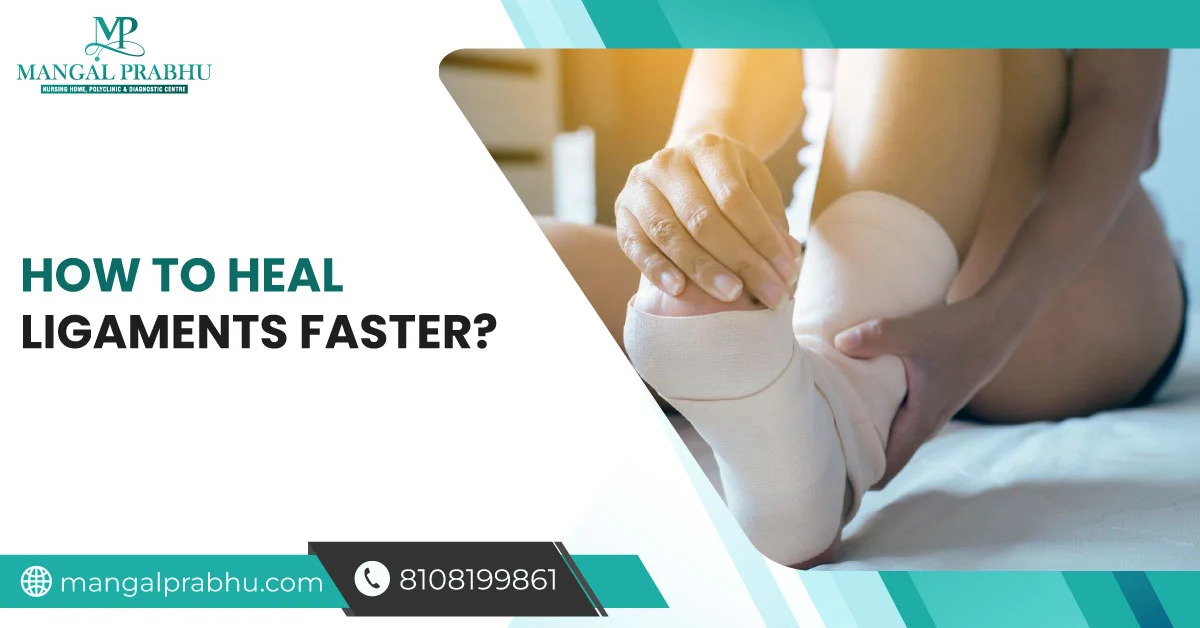
How to Heal Ligaments Faster?
Joints are complex systems of delivery consisting of string wire-like fibers named ligaments. These ligaments, despite being tough, still cannot be regarded as impregnable. They can break up and have sprains that may cause them pain and limit their motion. Thus, the best Orthopedic Hospital in Navi Mumbai can help an individual quickly diagnose and get the best possible treatment without any hassle. However, this guide takes up the issue of ligament injuries, revealing the tips of fast recovery and joint maintenance in the context.
1. What are Ligaments?
Ligaments allow stability to joints and are nothing like the strength of sturdy ropes connecting bones in your body. They do most of the job by inherently serving as the core support structures that hold the joints together while keeping any excessive motion at bay, which could lead to injury.
2. Causes of Ligament Injuries
- Sports injuries, such as twisting or overextending a joint during physical activity
- Accidents or falls that put stress on the ligaments
- Repetitive stress on the joints, common in occupations requiring repetitive motions
- Aging, which can weaken ligaments over time
3. Symptoms of Ligament Injuries
- Pain, especially when moving the affected joint
- Swelling and tenderness around the injured area
- Bruising or discoloration
- Instability or a feeling of the joint giving way
4. Risk Factors for Ligament Injuries
- Performing feet-on-ground activities or heavy sports, if not prepped or warmed up well, can be dangerous.
- Previous history of ligament injuries.
- Being overweight or obese can strain the joints.
- Having weak or imbalanced muscles around the joints.
5. How to Heal Ligaments Faster?
i) Proper Rest and Recovery
Grant your injured ligament the gift of rest, avoiding activities that exacerbate discomfort. Embrace aids like crutches or supportive braces to ease pressure.
ii) Ice Therapy
Ice becomes a soothing balm, applied regularly to the injured joint to quell swelling and alleviate pain.
iii) Compression
Grid up the injured area with bandages which have a squeezing force, and this fosters reductions of volume and proffers support.
iv) Elevation
Lay the healing member above the heart position when left alone (i.e. during rest periods) and watch blood flow improve through the reduction of swelling.
v) Physical Therapy
Work with a top-notch Orthopedic Doctor in Navi Mumbai at Mangal Prabhu Hospital who formulates treatment plans that propagate the development of supporting muscle.
vi) Medications
Medications help in reducing pain and get rid of inflammation when you consult your doctor.
vii) Surgical Interventions (if necessary)
In the worst cases, when ligament strength is available in hair’s width, the use of surgery reestablishes joint stability and function.
6. Tips for Preventing Ligament Injuries
- Warm-Up Rituals: Think of warm-ups before the exercise as the thing that prepares your muscles and ligaments for the challenges ahead.
- Weight Management: Maintaining a healthy weight would lessen the excess stress on your joints and ligaments.
- Mindful Movement: Avoid abrupt, uncontrolled movements, which can lead to some strain on your ligaments and keep going with smooth and soft motions instead.
7. Conclusion
Through the practice of rest, compensation remedies, prevention of injuries, and considering Mangal Prabhu Hospital, not only will you heal the ligaments faster, but also you will through a way build up the path of healthy joints to last forever.

What Not to Do After ACL Surgery?
I. Introduction
The ACL is the knee’s guardian, ensuring stability and support. When this guardian gets injured, ACL surgery swoops in to save the day, restoring function and preventing long-term outcomes for the patient. ACL injury can also develop life-threatening and immobility issues, thus this surgical procedure helps in eliminating these risks. ACL surgery also helps in improving stability, reducing the risk of future knee injuries, reducing pain, and swelling, and preventing chronic issues. Thus an individual must consult with the best ACL reconstruction doctors in Navi Mumbai at Mangal Prabhu Hospital to avoid risk associated with ACL injury.
II. Physical Activities to Avoid
After ACL surgery an individual needs to stay very conscious about their knee as straining the joint during this period may hinder the healing process. Thus, an individual must hold off on running, jumping, and jogging for a certain period; there’ll be plenty of time for that triumphant return later. These high-impact activities can stress the healing ligament. Give your knee rest, advance treatment, and avoid high-contact sports until it gets back to its full strength. It would also be best to avoid heavy weightlifting and intense exercise that might transform your knee’s healing period into an injury period. However, you can also adopt lighter weights and controlled strength training to stay on the track.
III. Neglecting Rehabilitation Exercises
Besides rest and avoiding physical activities, an individual also needs to consider various things during their recovery period after ACL surgery. Just like medicines are important for quick recovery, rehabilitation programs also act as a knee training camp. Rehabilitation exercise is a power move, aimed at defeating muscle atrophy and joint instability. Each exercise helps in improving the knee’s efficiency and acts as a shield for various complications. Rehabilitation program as a personal trainer, customizing workouts for your knee’s unique needs and progress. Skipping these customized workouts may hinder progress, slow down, and setbacks become more likely. Neglecting rehab also weakens the knee’s defense against the forces of delayed recovery.
Also Read: How to Sleep After ACL Surgery?
IV. Ignoring Pain and Swelling
Pain and swelling are warning signs of complications associated with knees. They’re signals from your body, telling you things are in motion. Keep a vigilant eye, and if the pain and swelling stay persistent and intense, then let your healthcare provider know immediately so they can offer the right treatment and avoid the risk of complications.
V. Returning to Normal Activities Too Soon
Impatience during your recovery period may lead to severe complications. The knee needs proper rest and treatment for a certain period after ACL reconstruction surgery in Navi Mumbai. Returning to normal activities too soon increases the risk of further injuries, infection, delayed recovery, and other long-term issues. Be a wise patient – follow the timeline, resist the urge, and let your knee heal properly, so you can go back to your normal activities without any hassle.
VII. Conclusion
During your ACL surgery recovery, each step is crucial. Evade the high-impact exercise, adopt the rehab exercises, keep an eye on the pain and swelling, and, most importantly, let your knee take its time to heal so you can get a better recovery. Patience and commitment are essential, ensuring a triumphant return to normalcy. Always consult with the healthcare provider at Mangal Prabhu Hospital for personalized guidance throughout this epic recovery journey.
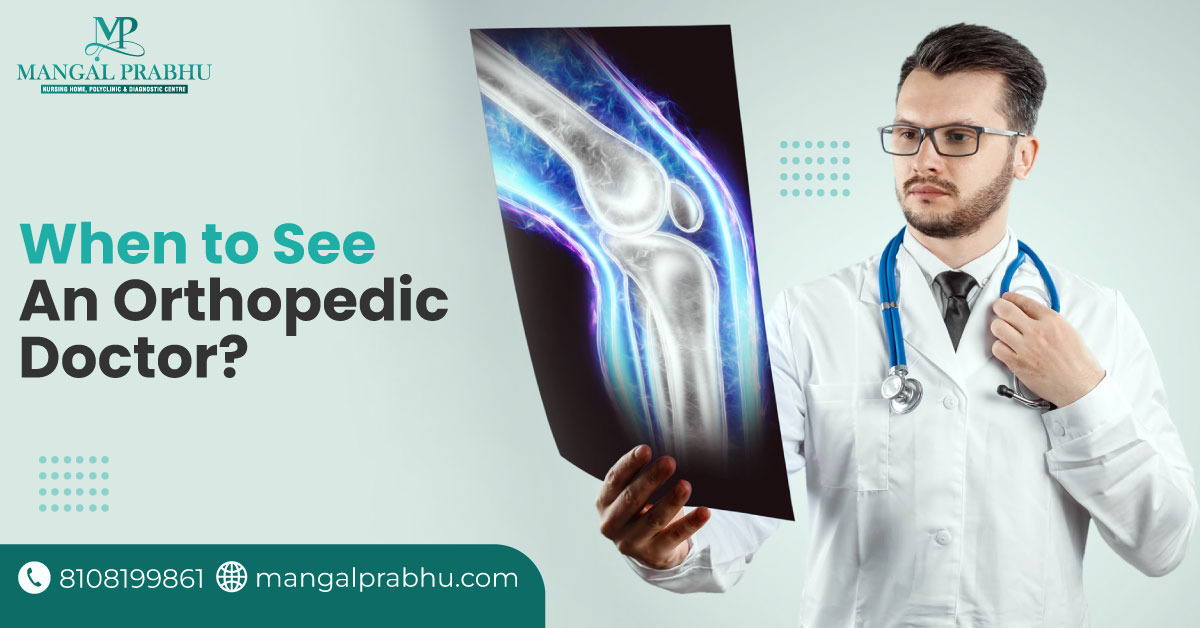
When to See an Orthopedic Doctor?
What is an Orthopedic Doctor?
Orthopedic health is pivotal in maintaining our overall well-being, ensuring that our bones, joints, and muscles function seamlessly. However, when musculoskeletal issues arise, seeking the expertise of an Orthopedic Doctor in Navi Mumbai becomes imperative.
Orthopedic doctors specialize in diagnosing, treating, and preventing conditions related to the musculoskeletal system. This intricate system comprises bones, joints, muscles, ligaments, and tendons, and any disruptions can lead to discomfort, pain, or restricted mobility.
Common Conditions Treated by Orthopedic Doctors
Orthopedic doctors are trained to address a wide range of musculoskeletal conditions, including:
1) Fractures and Dislocations
Prompt attention to fractures and dislocations is crucial for proper healing and preventing long-term complications.
2) Arthritis
Orthopedic doctors manage various forms of arthritis, such as osteoarthritis and rheumatoid arthritis, providing relief and enhancing joint function.
3) Sports Injuries
Athletes often consult orthopedic doctors to treat sports-related injuries like sprains, strains, and torn ligaments.
4) Back and Neck Pain
Conditions affecting the spine, such as herniated discs or spinal stenosis, are within the purview of orthopedic expertise.
5) Joint Replacement Surgery
Orthopedic surgeons perform joint replacement surgeries, such as knee or hip replacements, to alleviate pain and restore function.
Also Read: Is Orthopedic Surgery Worth it?
When to See an Orthopedic Doctor?
Knowing when to seek the expertise of an orthopedic doctor is crucial for timely intervention and effective treatment. Consultation is recommended in the following scenarios:
a) Persistent Pain or Discomfort
If you experience persistent pain or discomfort in your joints, bones, or muscles, it’s advisable to consult an orthopedic doctor. Ignoring such symptoms may lead to the progression of underlying conditions.
b) Limited Range of Motion
Difficulty moving a joint or experiencing a limited range of motion warrants orthopedic evaluation. It may indicate conditions such as arthritis or ligament injuries.
c) Injury or Trauma
In cases of injuries or trauma to the musculoskeletal system, seeking immediate orthopedic attention is vital. Fractures, dislocations, or severe sprains require professional evaluation and treatment.
d) Joint Deformities
Noticeable joint deformities or abnormalities should not be ignored. Orthopedic doctors can assess and provide appropriate interventions to address such issues.
Diagnostic Tests and Treatments for Orthopedic Conditions
Orthopedic doctors employ various diagnostic tests, including X-rays, MRI scans, and blood tests, to accurately identify musculoskeletal conditions. Treatment modalities range from non-invasive approaches like physical therapy and medication to surgical interventions when necessary.
Tips for Choosing the Right Orthopedic Doctor
Selecting the right orthopedic doctor is crucial for receiving optimal care. Consider the following tips:
i) Credentials and Expertise
Verify the doctor’s credentials, certifications, and expertise in treating specific orthopedic conditions.
ii) Hospital Affiliation
Ensure the orthopedic doctor is affiliated with a reputable Orthopedic Hospital in Navi Mumbai.
iii) Patient Reviews
Read patient reviews and testimonials to gauge the doctor’s reputation and satisfaction.
Conclusion
In orthopedic health, timely intervention can make a significant difference in outcomes. Recognizing the signs that warrant a visit to an orthopedic doctor and choosing the right professional is paramount for maintaining musculoskeletal well-being. Mangal Prabhu Hospital stands as a beacon of orthopedic care in Navi Mumbai, offering comprehensive solutions through its team of dedicated and experienced orthopedic doctors. Your journey to musculoskeletal health begins with the right orthopedic guidance, ensuring a life of mobility and vitality.
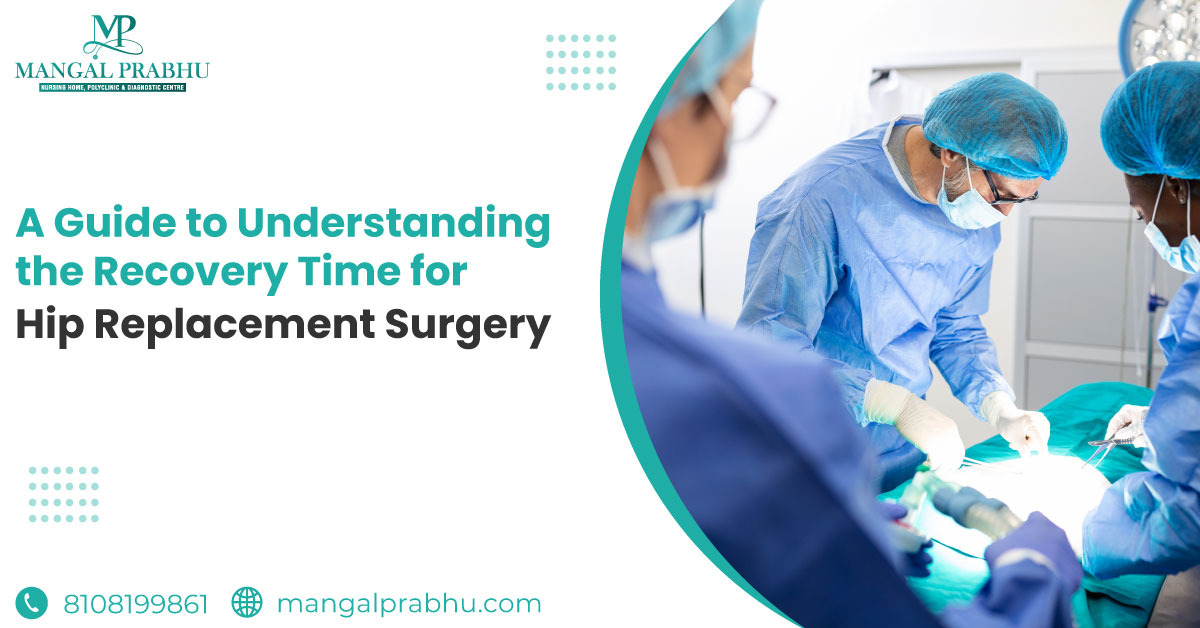
A Guide to Understanding the Recovery Time for Hip Replacement Surgery
Introduction
When it comes to recovery duration after hip replacement surgery, people are more likely to assume a more extended period than the actual recovery time. However, this guide has shed light on the recovery time and other aspects of hip replacement surgery so an individual can make a better decision before their hip surgery. Moreover, it would be best to consult with the best Hip Replacement Surgeon in Navi Mumbai from Mangal Prabhu Hospital to make a better decision regarding surgery.
Definition of Hip Replacement Surgery
Hip replacement surgery is a transformative solution for an individual suffering from the challenges of severe hip conditions. This surgical procedure helps in reducing pain and allows better flexibility, mobility, and functionality in daily work performance.
Benefits of Hip Replacement Surgery
- Patients often regain independence daily, as they can perform challenging tasks before the surgery.
- It removes the damaged part of the hip, which helps overcome chronic pain and improves quality of life.
- An individual can regain the functionality of their hip joint and can also improve mobility after the surgery. Thus, consulting with the best doctors at Mangal Prabhu Hospital for hip replacement surgery in Navi Mumbai would be the best to attain all the benefits.
Recovery Time for Hip Replacement
A. Immediate Recovery
This recovery period refers to the duration directly after the surgery when the patient is closely monitored in the hospital to avoid complications. The doctor may suggest pain management and mobility exercises during this period.
B. Short-Term Recovery
This period starts after discharge from the hospital and may last for up to six weeks. During this period, patients gradually regain mobility and begin physical therapy.
C. Long-Term Recovery
This period starts from the initial six weeks after surgery to several months or years. A patient continues therapies and other precautions to regain optimal joint function.
What to Expect During Recovery
a. Pain Management
Medications, both oral and sometimes intravenous, are prescribed to control pain levels. As healing progresses, the reliance on pain medications typically decreases.
b. Physical Therapy
Physical therapy helps in improving strength, flexibility, and joint function. Therapists guide patients through exercises that enhance mobility and stability, focusing on the hip and surrounding muscles.
c. Diet and Nutrition
A balanced diet rich in nutrients and an adequate protein intake supports muscle recovery, while vitamins and minerals contribute to overall health.
Tips for a Smooth Recovery
i. Follow the Directions of the Doctor and Physical Therapist
Adhering to the recommendations and instructions provided by the medical team is crucial. It includes taking medications as prescribed, attending physical therapy sessions, and following any activity restrictions.
ii. Listen to Your Body
It would be best to rest and perform activities according to an individual’s body needs, which helps reduce potential pain and discomfort.
iii. Maintain a Positive Mindset
Patience is vital, as improvements may be gradual. Staying optimistic and celebrating small milestones can help alleviate emotional challenges during recovery.
V. Conclusion
Hip replacement surgery offers significant benefits for individuals suffering from hip-related issues. However, it would be best to understand the recovery time and consult the best surgeon before surgery to get the best possible solution.
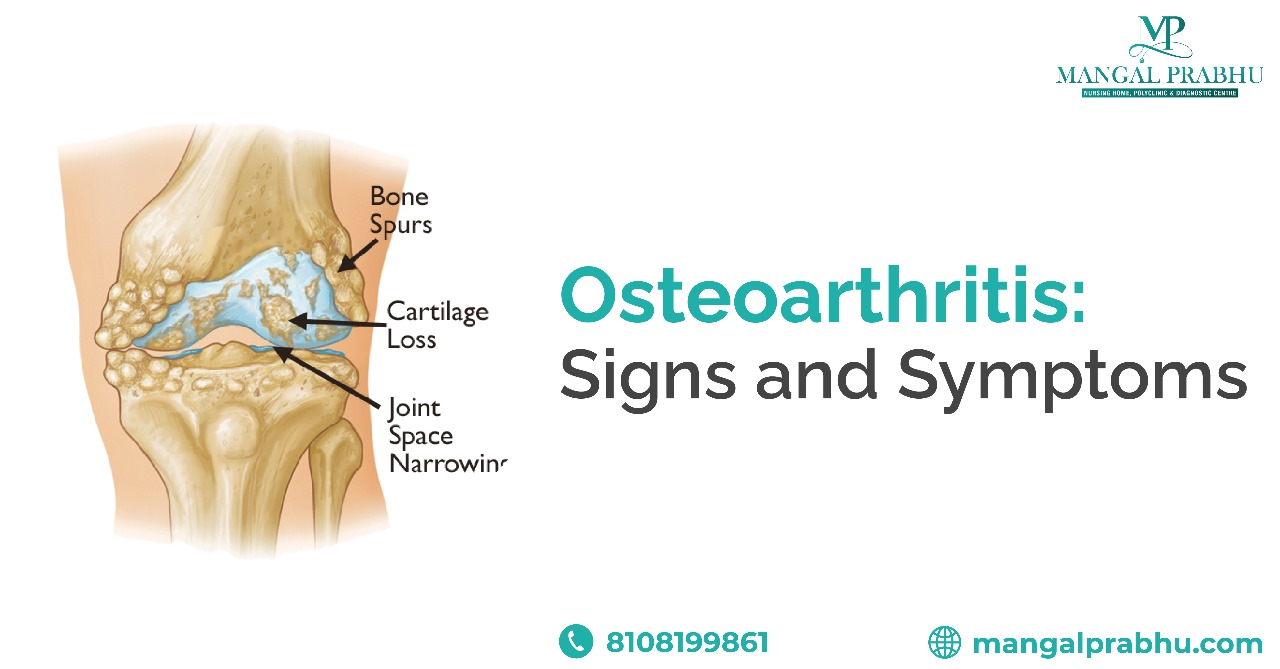
Osteoarthritis: Signs and Symptoms
What is Osteoarthritis?
Osteoarthritis is the most common form of arthritis that can affect your hip, knee, and hand joints. In osteoarthritis, the cartilage that serves as a cushion for your joints can get damaged either due to aging or other causes. When the cartilage is worn, the bones might rub together when you walk, move, or engage the affected joint. You can visit an orthopedic hospital in Navi Mumbai to discuss the best treatment for osteoarthritis.
The condition can affect your mobility severely, as you won’t be able to use your joints as freely as before. Although many home remedies and medications can help manage your pain and discomfort, they can’t reverse the joint damage. For that, you may need knee replacement surgery (depending on how severely it has affected you).
Signs and Symptoms of Osteoarthritis
The most common cause of osteoarthritis is aging. As you age, your cartilage wears down, limiting your motion. However, any fall, a direct hit on your joint, an accident or anything that damages your joint can lead to cartilage damage and hence osteoarthritis. Anyone can develop osteoarthritis, but some people are at increased risk. Examples include older people, diabetic patients, and those with autoimmune diseases.
People with osteoarthritis might develop symptoms that tend to worsen gradually. Here are the common signs of the condition.
- Stiff Joints: You might feel stiff joints as soon as you wake up or stay inactive for some time.
- Pain and Tenderness: You will feel pain when walking, moving, or performing any strenuous physical activity. Likewise, putting any pressure near or on the affected joint might hurt.
- Inflexible Joints: Osteoarthritis can result in the loss of mobility eventually. The condition keeps worsening over time until you will lose your full range of motion.
- Popping Sound: You might hear a popping sound when using the affected joint.
- Inflammation: The worn joint can get inflamed and cause swelling.
Also Read: Is Walking Good For Torn Ligaments?
Diagnosis and Treatment
An orthopedic doctor in Navi Mumbai will conduct a physical exam and order a few screening tests, including a CT scan and MRI, to identify the level of damage to your cartilage. They will ask questions like, how long you have been experiencing the symptoms. They might also order blood tests to rule out the possibility of any other issues.
Here are a few treatment options that can make the condition manageable.
- Medication: Over-the-counter painkillers can relieve pain in the joints. It can be taken orally or in the tropical form, through ointment.
- Exercise and Therapies: Mild exercises like swimming and aerobics can help strengthen the muscles around the affected area and reduce joint tenderness and stiffness. Hot and cold therapies can also relieve the pain and discomfort greatly.
- Using Mobility Devices: You’ll be advised to use a cane and other walking aids to take the pressure off your joint and move without pain.
Surgery is usually not required unless the condition has worsened to a point where you can’t move your joint at all. In that case, you need a complete joint replacement surgery.
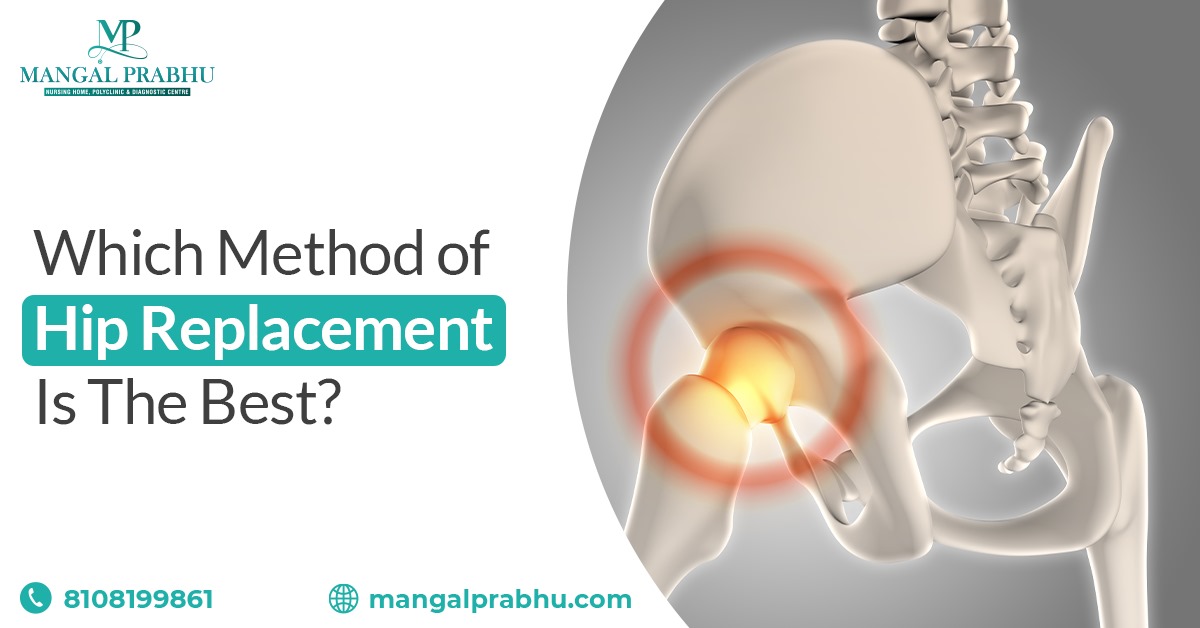
Which Method Of Hip Replacement Is The Best?
Introduction
Hip replacement surgery is a common orthopedic procedure to relieve pain and improve mobility in individuals with hip joint issues. However, with various methods available, patients often wonder which is the best approach for their specific condition. Here, you can explore different types of hip replacement procedures and their advantages and disadvantages. It will help you understand which hip replacement method is most suitable for you.
Different Types of Hip Replacement Procedures
Hip replacement surgery offers several approaches tailored to the patient’s condition and requirements. The three primary methods are:
1. Total Hip Replacements
Total hip replacements involve replacing the hip joint’s ball and socket with prosthetic components. This procedure is suitable for patients with severe arthritis, joint degeneration, or significant damage to the hip joint.
2. Partial Hip Replacements
Partial hip replacements, also known as hip hemiarthroplasty, involve replacing only the damaged or diseased portion of the hip joint, typically the ball component. This method is often chosen for specific hip fractures or conditions that affect only one part of the hip joint.
3. Revision Hip Replacements
Revision hip replacements are performed when a previous hip replacement has failed or needs to be replaced due to various reasons, such as wear and tear of the prosthetic components or infection.
Advantages and Disadvantages of Each Method
Each method of hip replacement has its unique advantages and disadvantages:
Advantages of Total Hip Replacements
- Effective for severe hip joint damage.
- Provides long-term relief from pain and improved joint function.
- Suitable for various hip conditions, including osteoarthritis and rheumatoid arthritis.
Also Read: Lifetime Precautions After A Hip Replacement
Disadvantages of Total Hip Replacements
- More extensive surgery with longer recovery time.
- Greater risk of dislocation.
Advantages of Partial Hip Replacements
- Smaller incisions and less bone removal lead to quicker recovery.
- Reduced risk of dislocation.
- Suitable for specific hip fractures or localized joint damage.
Disadvantages of Partial Hip Replacements
- Limited applicability to certain conditions.
- It may require a second surgery if the entire joint deteriorates over time.
Advantages of Revision Hip Replacements
- Corrects issues with previous hip replacements.
- Replaces worn or damaged prosthetic components.
- Restores joint function.
Disadvantages of Revision Hip Replacements
- It is more complex than primary hip replacements.
- Longer recovery and rehabilitation.
Which Method of Hip Replacement is the Best?
The choice of the best method of hip replacement depends on individual factors, such as the patient’s age, the severity of the hip condition, and the surgeon’s assessment. There is no one-size-fits-all answer to this question, as what works for one patient may not be suitable for another. The decision should be made in consultation with an experienced hip replacement surgeon, such as a Hip Replacement Surgeon in Navi Mumbai at Mangal Prabhu Hospital. A skilled surgeon will conduct a thorough evaluation, consider the patient’s needs, and recommend the most appropriate treatment method.
Conclusion
In conclusion, there is no definitive answer to which hip replacement method is the best, as it varies from patient to patient. The choice depends on individual circumstances and the expertise of the surgeon. What is essential is that patients seek expert care from facilities like Mangal Prabhu Hospital, which specializes in Hip Replacement Surgery in Navi Mumbai. With the guidance of experienced professionals, patients can receive the most suitable hip replacement procedure to improve their overall quality of life.
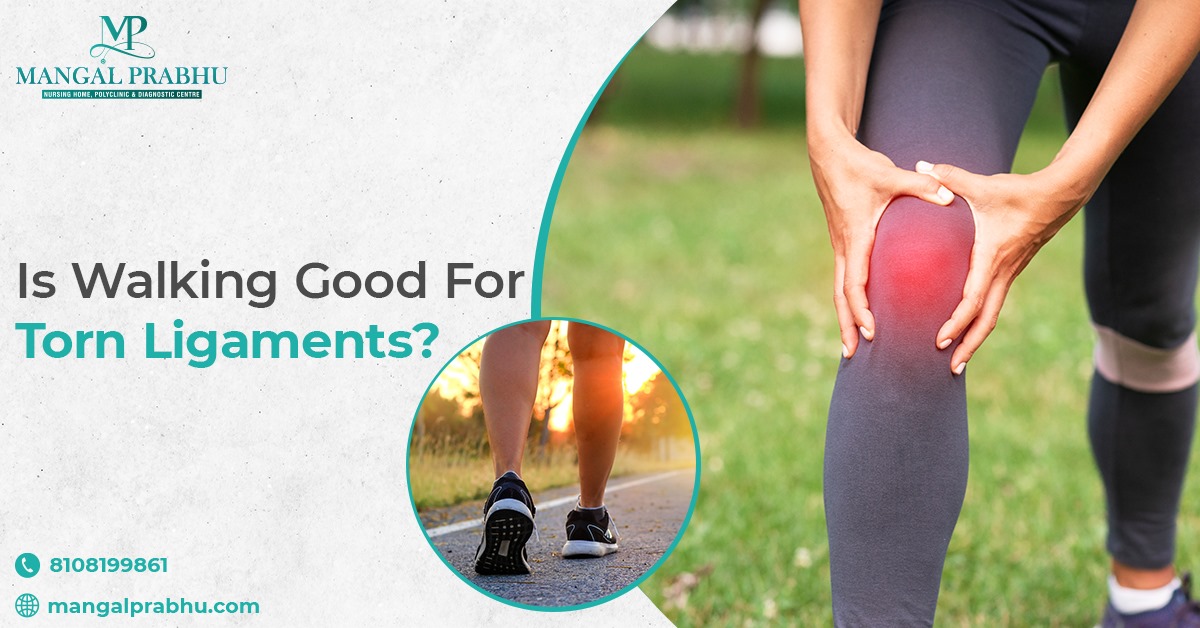
Is Walking Good For Torn Ligaments?
Torn ligaments can be a painful and debilitating injury, often raising questions about appropriate activities during the healing process. This article will explore the nature of torn ligaments, their symptoms, diagnosis, and whether walking is a suitable exercise during recovery. Here, you can also learn about the Mangal Prabhu Hospital. It is a trusted healthcare facility with an experienced Knee Replacement Surgeon in Navi Mumbai.
What are Torn Ligaments?
Ligaments are strong, fibrous bands of tissue that connect bones. They also provide stability to joints. When subjected to excessive force or trauma, these ligaments can tear. Hence, it results in a condition known as a torn ligament. This injury most commonly occurs in joints like the knees and ankles.
What are the Symptoms of Torn Ligaments?
Torn ligaments typically present with a set of distinct symptoms, including:
- Pain and Tenderness
- Swelling and Bruising
- Limited Range of Motion
- Joint Instability
- Popping or Snapping Sensation
How to Diagnose Torn Ligaments?
Accurate diagnosis of torn ligaments is crucial for determining the appropriate course of treatment. A healthcare professional will typically use a combination of methods, including:
i) Physical Examination:
The healthcare provider will examine the injured area, looking for signs of swelling, tenderness, and joint stability.
ii) Imaging Tests:
X-rays or MRI scans may be ordered to assess the extent of the ligament injury and rule out any accompanying bone damage.
iii) Medical History:
A detailed discussion of the injury, including how it occurred and the progression of symptoms, is essential for diagnosis.
Also Read: Is Orthopedic Surgery Worth It?
Is Walking Good For Torn Ligaments?
Walking can be a beneficial activity during the recovery from torn ligaments. But you should approach it with caution and under the guidance of a healthcare professional. In many cases, initial treatment may involve rest and immobilization. However, controlled and gentle walking exercises may be introduced as part of a rehabilitation program as healing progresses.
Walking can help maintain joint mobility, prevent muscle atrophy, and improve blood circulation, all supporting healing. Following a structured rehabilitation program prescribed by a medical professional is crucial. Attempting to resume normal walking too soon or overexerting oneself can delay healing or lead to further injury.
Other Exercises That Can Help Reduce Pain and Heal Torn Ligaments
In addition to walking, various exercises can aid in reducing pain and promoting the healing of torn ligaments. These exercises may include:
- Range of Motion Exercises.
- Strengthening Exercises.
- Balance and Stability Exercises.
- Low-impact activities such as swimming or stationary cycling can improve cardiovascular fitness without placing excessive stress on the injured ligament.
Conclusion
Walking can be beneficial during the recovery from torn ligaments, provided it is done cautiously and under professional guidance. Initial treatment often involves rest, but a structured rehabilitation program may incorporate walking and other exercises as healing progresses.
If you have suffered a ligament injury or require expert guidance on your recovery, consult knee replacement surgeons at Mangal Prabhu Hospital, a leading Knee Replacement Hospital in Navi Mumbai. Remember that patience, adherence to the prescribed treatment plan, and avoiding activities that could hinder healing are key to a successful recovery.
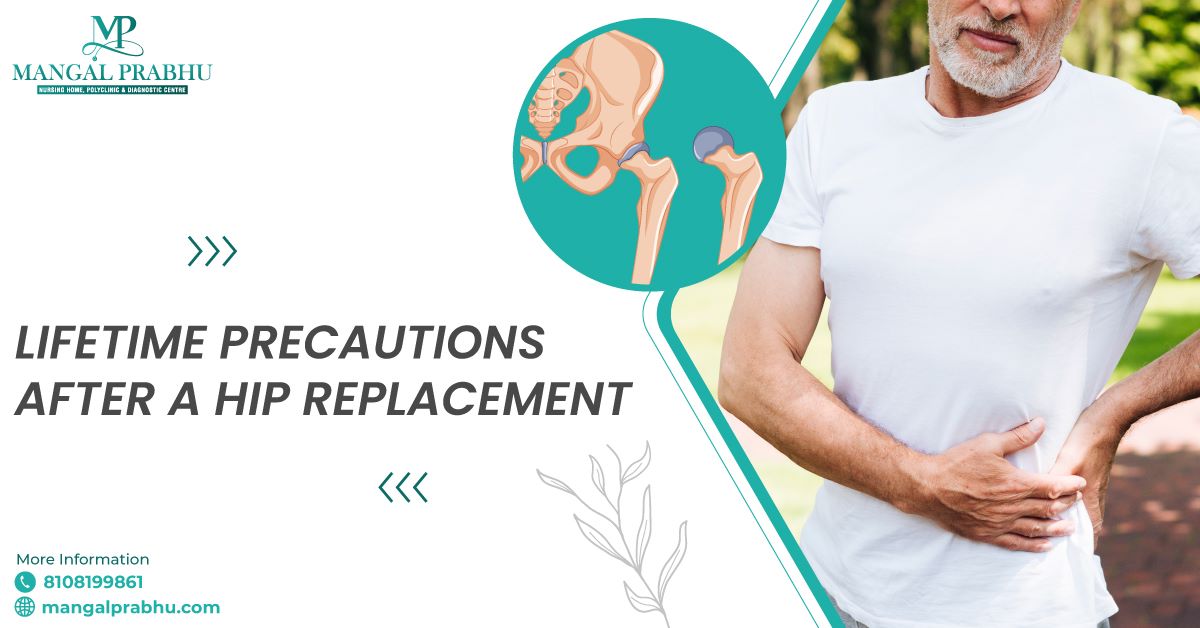
Lifetime Precautions After a Hip Replacement
Generally, seniors undergo hip replacement surgery to improve mobility and reduce pain. If you know someone undergoing this surgery, you must ensure they know the lifetime precautions. The Hip Replacement Surgeon in Navi Mumbai educates its patient about lifetime precautions after their procedure. Individuals can ensure a successful and long-lasting outcome by following these precautions and taking care of the new joint. In this blog, you can explore the essential lifetime precautions after a hip replacement.
Understanding the Lifetime of a Hip Implant
Before learning about the lifetime precaution, let’s learn about the lifetime of the hip implant. These implants can vary in material and design. The lifespan of hip implants depends on multiple factors, such as their type and the individual’s lifestyle. On average, most hip replacements continue to function well even after ten years, and many can last a lifetime. You must consult with the surgeon from Orthopedic Hospital in Navi Mumbai about the specific characteristics of the implant and its expected longevity to ensure appropriate care.
Precautions to follow after Hip Replacement Surgery
People with hip replacement surgery should follow these precautions from Mangal Prabhu Hospital, including:
1. Crossing Legs and Twisting Movements
Avoid crossing legs and twisting movements, including pivoting on one leg and walking pigeon-toed, should be avoided to minimize the risk of dislocation. Side sleepers may find sleeping with a pillow between their legs beneficial to maintain proper alignment. It’s important to be mindful of these movements and make conscious efforts to protect the hip joint.
2. Bending Too Far
Excessive hip flexion can lead to dislocation, so seniors should avoid bending the hip joint beyond 90 degrees. Activities like putting on socks or shoes should be done with caution. Choosing appropriate seating, like chairs with the thighs parallel to the floor, helps maintain the correct angle. Tall individuals may need elevated cushions for chairs or toilet seats to prevent over-bending.
Also Read: How To Sleep After ACL Surgery?
3. Repetitive, High-Impact Activities
While exercise is essential for maintaining muscle tone and balance, certain activities can strain the hip implant excessively. Repetitive motions and high-impact exercises like running and jumping should be avoided. Instead, low-impact exercises such as swimming, yoga, and stationary biking are recommended to restore range of motion without risking damage to the implant.
4. Air Travel Considerations
If the hip implant contains metal, it may set off metal detectors at airport security checkpoints. Informing the TSA agent about the presence of a metal hip implant is advisable. Full-body scanners are usually more effective at detecting internal metal. Still, even if the alarm sounds, it’s typically resolved with a physical pat-down or electromagnetic wand screening to ensure safety.
Conclusion
By following the lifetime precautions after a hip replacement, individuals can maintain the integrity of their new joint and enjoy a fulfilling life. Seniors should prioritize low-impact exercises and be aware of air travel considerations. Elderly people also avoid excessive bending and twisting. It will contribute to the long-term success of hip replacement surgery. Consult healthcare professionals at Mangal Prabhu Hospital for personalized advice throughout the journey. They will help you manage your pain and prevent complications.

How to Sleep After ACL Surgery?
Anterior Cruciate Ligament or ACL surgery removes the torn ligament from your knee and replaces it with an artificial one to restore your knee function. The ligament could be either removed fully or preserved, depending on the severity of the injury. Your orthopedic surgeon in Navi Mumbai will brief you on the postoperative recovery.
Although the surgery doesn’t usually take more than 2 hours, patients might experience discomfort for a few days following the operation. The biggest question is how do you sleep during the recovery phase? Which posture is the best? Let’s find out.
Use Compression Stockings to Prevent Blood Clots
You need to wear compression stockings for 2-3 weeks post your ACL reconstruction surgery in Navi Mumbai. It helps prevent blood clot formation on the treated site and reduces pain and inflammation. It also helps you sleep comfortably.
You may have to continue the use of compression stockings at least until the sutures have not been removed and healed. Keep your affected area covered in this wrap every day and for 24 hours. You can remove it when taking a shower or changing the wrap.
Use Ice to Reduce Swelling
Post-surgical pain is common. While the doctor might give you over-the-counter medication to relieve the pain, you can try some home remedies too. Ice massage, for example, is a highly effective method to reduce swelling. Massage the injured site with ice packs twice a day—in the morning and before going to bed. This will reduce the pain, helping you fall asleep faster.
Also Read: Is Orthopedic Surgery Worth It?
Choose the Right Sleeping Position
After the surgery, you should sleep on your back with your treated leg raised slightly upward above your heart. Remember, finding the right sleeping position after ACL surgery is extremely important. A position that applies too much pressure on your affected leg will not only cause discomfort but can slow your healing.
Patients healing from ACL surgery should sleep in a supine position, i.e. on their back instead of the stomach or side. Put a soft pillow beneath your leg to elevate it comfortably. This will alleviate pain, improve blood circulation, and reduce muscle tension.
Clean Your Bandage Regularly
Infection after the operation can be avoided by cleaning your bandage frequently and keeping it dry at all times. Note that wet stockings will serve as the breeding ground for germs, leading to infection on the wounded site. Besides that, it creates moisture on the leg, which can slow down your healing. A good hygienic practice for patients undergoing ACL surgery would be to remove the bandage before going to sleep, apply ointment, and wrap a new bandage.
Take OTC for Pain Management
Pain makes it difficult to fall and stay asleep after the ACL surgery. You can take over-the-counter medication to reduce pain and swelling. The anti-inflammatory medication will relieve the pain and help you have a good night’s sleep.
However, prescription medication can have side effects and might lead to addiction if taken in inappropriate dosage. It’s advisable to discuss your condition and sleep issues with the doctor to find the best solutions.
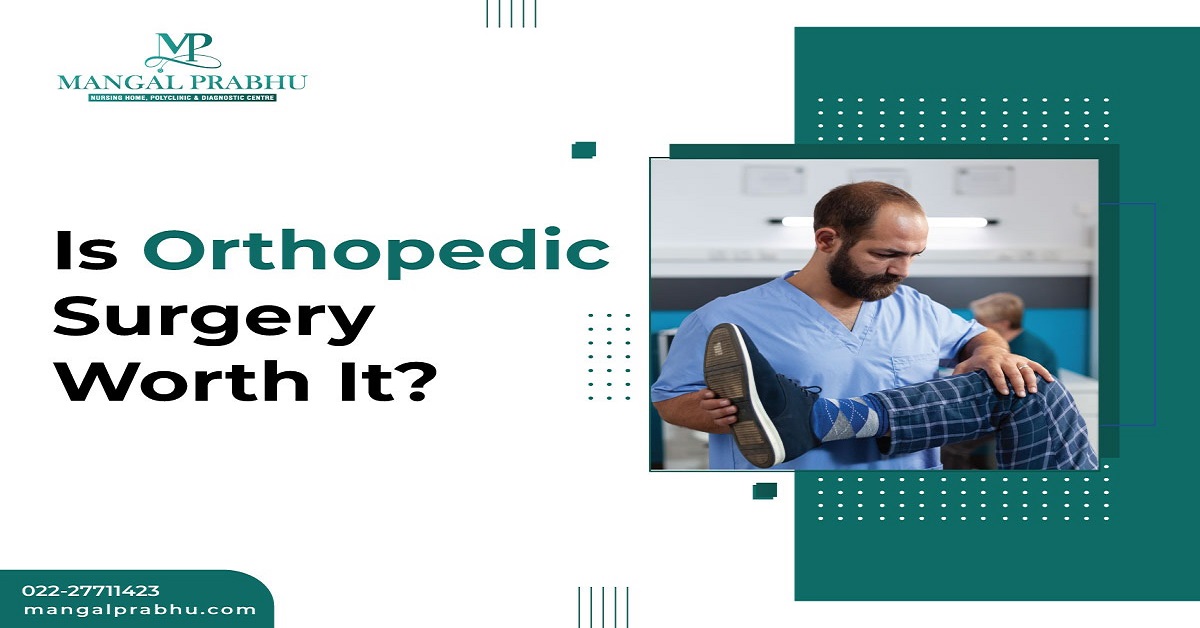
Is Orthopedic Surgery Worth it?
What Is Orthopedic Surgery?
Orthopedic is the area of medicine that focuses on the evaluation, treatment, and preventive measures of issues and injuries of the musculoskeletal system, which includes the bones, joints, muscles, tendons, and ligaments that provide support, stability, and movement to the body. Orthopedic conditions can vary from minor injuries, such as sprains and strains, to more severe conditions, such as arthritis, osteoporosis, and degenerative disc disease.
Types of Orthopedic Treatment:
Orthopedic experts, commonly known as orthopedic surgeons are medical doctors who specialize in the diagnosis and treatment of these conditions. They are trained to administer a variety of techniques to treat orthopedic conditions, including non-surgical and surgical approaches. Non-surgical treatments include physical therapy, medications, and orthotic tools, such as braces or casts, that help support and immobilize affected areas in the body. The surgical treatments include procedures such as joint replacement, spinal fusion, and arthroscopic surgery.
According to an Orthopedic Hospital in Navi Mumbai, these procedures are typically used for more severe conditions that do not respond effectively to non-surgical methods. Let us understand if this type of surgery is necessary and if it is worth it.
The decision of whether or not orthopedic surgery is worth it depends on various factors such as the specific condition that is being treated, the severity level of the condition, the patient’s overall health condition and lifestyle, and the potential risks and benefits of the surgery.
Advantages of Orthopedic Surgery:
In many cases, an orthopedic surgery can be highly effective in relieving pain, improving mobility, and restoring function to the affected area. As per an example given by one of the best Orthopedic Surgeon in Navi Mumbai, joint replacement surgery, such as a knee or hip replacement, can be life-changing for people with serious arthritis or joint damage, allowing them to regain mobility and live a higher quality of life.
Risks & Benefits of Orthopedic Surgery:
However, like any surgery, there are risk factors associated with orthopedic surgery, including infection, bleeding, and anesthesia complications. In addition, recovery from orthopedic surgery can be a lengthy process and can require a significant commitment to physical therapy and rehabilitation.
It’s important for patients to weigh the potential risks and benefits of orthopedic surgery and to have realistic expectations about the result of the surgery. People should first gain full understanding and knowledge from their orthopedic surgeon about the procedure, potential risks, and the recovery process.
Conclusion:
In many cases, non-surgical treatments such as physical therapy, medications, and lifestyle alterations can be impactful in managing orthopedic conditions and improving symptoms and surgery may not be required. But, the decision of whether or not orthopedic surgery is worth it is highly dependable on the individual’s condition and such a decision should be made in consultation with a qualified orthopedic surgeon.
